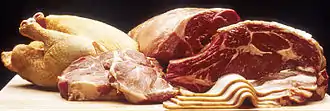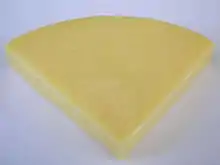Animal source foods
Animal source foods (ASF) include many food items that come from an animal source such as fish, meat, milk, eggs, honey, cheese and yogurt. Many individuals do not consume ASF or consume little ASF by either personal choice or necessity, as ASF may not be accessible or available to these people.[1]


Health impacts of micronutrient deficiency
All six micronutrients richly found in ASF, vitamin A, vitamin B12, riboflavin, calcium, iron and zinc play a critical role in the growth and development of children.[1][2] Inadequate stores of these micronutrients, either resulting from inadequate intake or poor absorption, is associated with poor growth, anemias (iron deficiency anemia and macrocytic anemia), rickets, night blindness, impaired cognitive functioning, neuromuscular deficits, diminished work capacity, psychiatric disorders and death.[1] Some of these effects, such as impaired cognitive development from an iron deficiency, are irreversible.
Animal source food supplementation
Micronutrient deficiency is associated in poor early cognitive development.[3] Programs designed to address these micronutrient deficiencies should be targeted to infants, children, and pregnant women. To address these significant micronutrient deficiencies, some global health researchers and practitioners developed and piloted a snack program in Kenya school children.[4] However, some communities are vegetarians for religious or cultural reasons. Efforts must be made to develop culturally appropriate interventions to address the micronutrient deficiencies in these populations, such as through food fortification.
Animal source food production
According to a 2006 United Nations initiative, the livestock industry sector emerges as one of the top two or three most significant contributors to the most serious environmental problems, at every scale from local to global."[5] As such, using plant-derived foods is typically considered better for the interests of the environment. Despite this, the raising of certain animals can be more environmentally sound than others. According to the Farralones Institute's report from 1976, raising rabbits, and chickens (on a well-considered approach) for food can still be quite sustainable.[6] As such, the production of meat and other produce, such as eggs, may still be considered environmentally friendly (if this is done in an industrial, high-efficiency manner). In addition, raising goats (for goat milk and meat) can also be environmentally quite friendly and has been favored by certain environmental activists, such as Mahatma Gandhi.[7]
The planetary diet of the EAT-Lancet commission has advised substantial reductions in consumption of ASF on the basis that these diets threaten sustainability because of their environmental footprint and negative health impacts.[8] This report was challenged by Adegbola T. Adesogan and colleagues in 2020 who stated that it "fail[ed] to adequately include the experience of marginalized women and children in low- and middle-income countries whose diets regularly lack the necessary nutrients" and ASF offer the best source of nutrient rich food for children aged 6–23 months.[9]
See also
References
- Murphy SP, Allen LH. (2003) Nutritional Importance of Animal Source Foods. J. Nutr. 133: 3932S-3935S.
- Black, MM. (2003) Micronutrient Deficiencies and Cognitive Functioning. J. Nutr. 133: 3927S-3931S.
- Black MM. (2003) Micronutrients and Cognitive Functioning. J Nutr.133: 3927S-3931S.
- Siekmann JH, Allen LH, Bwibo NO, Demment MW, Murphy SP, Neumann CG (2003). Kenyan School Children Have Multiple Micronutrient Deficiencies, but Increased plasma vitamin B12 is the only detectable micronutrient response to meat or milk supplementation. J. Nutr. 133. 3972S-3980S.
- LEAD digital library: Livestock’s long shadow - Environmental issues and options Archived 2014-08-06 at the Wayback Machine
- Farralones Institute favoring rabbits and chicken, 1976
- Gandhi, who favored the environmentally friendly goat and its produce Archived June 28, 2008, at the Wayback Machine
- Willet, W; Rockstrom, J; Loken, B; Springmann, M; Lang, T; Vermeulen, S; Garnett, T; Tilman, D; DeClerck, F; Wood, A; Jonell, M (2019). "Food in the Anthropocene: the EAT-Lancet Commission on healthy diets from sustainable food systems". The Lancet. 393 (10170): 447–492.CS1 maint: multiple names: authors list (link)
- Adesogan, Adegbola T; Havelaar, Arie H; McKune, Sarah L; Eilitta, Marjatta; Dahl, Geoffrey, E. (2020). "Animal source foods: Sustainability problem or malnutrition and sustainability solution? Perspective matters". Global Food Security. 25: 100325.CS1 maint: multiple names: authors list (link)
